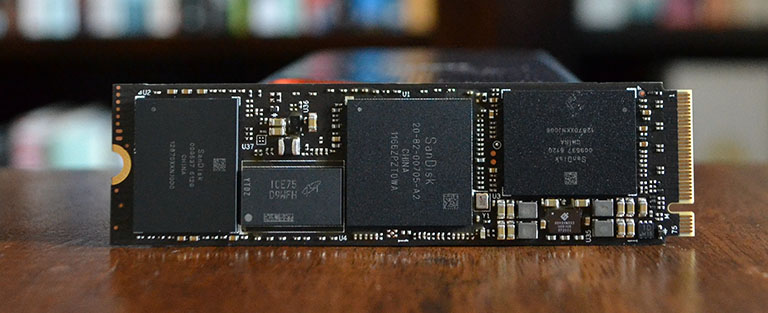Introduction
Storage giant WD splits its eponymous internal solid-state drives (SSDs) into six recognisable families. Performance is taken care of by various speedy drives under the Black umbrella, enterprise by Gold, surveillance through Purple, mainstream models assemble under Blue, Green is for entry-level models, and flying under the radar for most PC enthusiasts is Red.
The latter is designed primarily for network-attached storage (NAS) boxes and duly focusses on consistent performance and longevity. Up until today, however, Red's only SSD participant was the SATA-based SA500 (2.5in or M.2) available in 500GB, 1TB and 2TB capacities.
WD reckons it's time to bump up performance credentials of Red through trickle-down technology. Today sees the release of M.2 NVMe solutions known as Red SN700 and comprising drives from 250GB to 4TB. Let's take a closer look.
Specifications |
||||||
|---|---|---|---|---|---|---|
| Series | WD Red SN700 |
|||||
| Nominal Capacity | 250GB |
500GB |
1000GB |
2000GB |
4000GB |
|
| Controller | WD In-house |
|||||
| NAND | SanDisk TLC |
|||||
| Encryption | - |
|||||
| Interface | PCIe Gen 3 x4 |
|||||
| DRAM | SK hynix DDR4 |
|||||
| Sequential Read Speed | 3,100MB/s |
3,430MB/s |
3,430MB/s |
3,400MB/s |
3,400MB/s |
|
| Sequential Write Speed | 1,600MB/s |
2,600MB/s |
3,000MB/s |
2,900MB/s |
3,100MB/s |
|
| Random IOPs (4KB Reads) | 220K IOPS |
420K IOPS |
515K IOPS |
480K IOPS |
550K IOPS |
|
| Random IOPs (4KB Writes) | 180K IOPS |
380K IOPS |
560K IOPS |
540K IOPS |
520K IOPS |
|
| Average Maximum Power | 9.24W |
|||||
| Low Power (PS3) | 70mW |
70mW |
100mW |
100mW |
100mW |
|
| Available Form Factors | M.2 2280 |
|||||
| Endurance | 500TBW |
1,000TBW |
2,000TBW |
2,500TBW |
5,100TBW |
|
| Life Expectancy | 1.75m hours |
|||||
| Warranty | 5 Years |
|||||
| MSRP | £56 |
£77 |
£153 |
£306 |
£562 |
|
Optimised for premium NAS boxes using NVMe M.2 SSDs for caching purposes, WD isn't overly forthcoming with the technology used by the quintet of SN700 drives.
Nevertheless, the naming and speeds give much of the technical game away. Specifications are almost perfectly in line with the WD Black SN750 series released in early 2019. At that time, those Black drives were the creme de la creme, but have since been superseded by PCIe Gen x4 models touting double the sequential and IOPS performance.
The guts of SN750 are not a bad place to start, mind, and the 2280 form factor makes a lot of sense. There's nothing fancy in the aesthetics department. A simple sticker covers four chips on the top side. On our 1TB sample the rear is unadorned.
What makes these NAS-specific drives instead of ordinary Black or Blue? Good question. The answer mostly rests with endurance. This PCIe 3.0 x4 1TB model is furnished with a 2,000 TBW rating, compared to only 600 TBW for the same-capacity SN750.
This over 3x boost is important in environments where the SSD is likely to be used more frequently - always-on NAS boxes being the cited example - and translates to over one complete driver write per day (DWPD) over the five-year warranty period. You'd do well to fatigue the drive on endurance alone.
Such longevity is built on having more faith in controllers and TLC NAND these days. It's not at all surprising to see WD using very similar technology as on SN750, though the controller, labelled SanDisk 20-82-000705-A2, is a derivation of that model.
We see the same SK hynix buffering chip and two 512GB NAND devices from subsidiary SanDisk. WD is not telling us exactly what they are, but 64-layer TLC, per SN750, is a good guess.
These drives' Red status doesn't preclude them being used in a standard consumer environment. We'd encourage such usage if your workstation or PC needs far better endurance capability than regular consumer drives.
Priced at £153 for the 1TB review model, the cost is largely where we expect it to be, especially when compared with other decent PCIe 3.0 x4 drives equipped with top-class endurance.
It's been a while since WD invigorated its line of Red NAS-optimised drives. The Red SN700 series has all the chops on paper, so let's run some benchmarks and find out if the performance claims are true.




